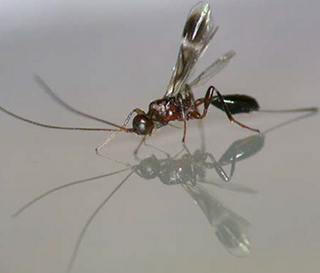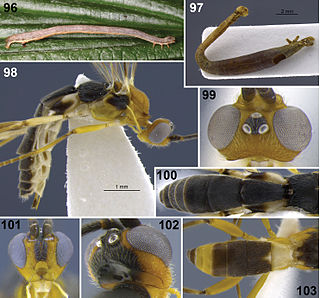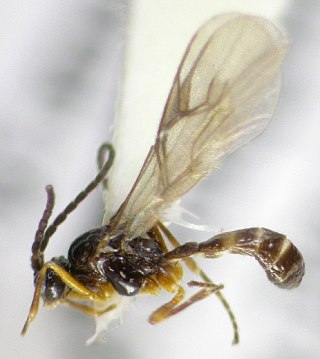
Sawflies are wasp-like insects that are in the suborder Symphyta within the order Hymenoptera, alongside ants, bees, and wasps. The common name comes from the saw-like appearance of the ovipositor, which the females use to cut into the plants where they lay their eggs. The name is associated especially with the Tenthredinoidea, by far the largest superfamily in the suborder, with about 7,000 known species; in the entire suborder, there are 8,000 described species in more than 800 genera. Symphyta is paraphyletic, consisting of several basal groups within the order Hymenoptera, each one rooted inside the previous group, ending with the Apocrita which are not sawflies.

The Braconidae are a family of parasitoid wasps. After the closely related Ichneumonidae, braconids make up the second-largest family in the order Hymenoptera, with about 17,000 recognized species and many thousands more undescribed. One analysis estimated a total between 30,000 and 50,000, and another provided a narrower estimate between 42,000 and 43,000 species.

Parasitoid wasps are a large group of hymenopteran superfamilies, with all but the wood wasps (Orussoidea) being in the wasp-waisted Apocrita. As parasitoids, they lay their eggs on or in the bodies of other arthropods, sooner or later causing the death of these hosts. Different species specialise in hosts from different insect orders, most often Lepidoptera, though some select beetles, flies, or bugs; the spider wasps (Pompilidae) exclusively attack spiders.

Glyptapanteles is a genus of endoparasitoid wasps found in all continents, except Antarctica. The larvae of Glyptapanteles species are able to manipulate their hosts into serving as bodyguards.

A wasp is any insect of the narrow-waisted suborder Apocrita of the order Hymenoptera which is neither a bee nor an ant; this excludes the broad-waisted sawflies (Symphyta), which look somewhat like wasps, but are in a separate suborder. The wasps do not constitute a clade, a complete natural group with a single ancestor, as bees and ants are deeply nested within the wasps, having evolved from wasp ancestors. Wasps that are members of the clade Aculeata can sting their prey.

Microgastrinae is a subfamily of braconid wasps, encompassing almost 3,000 described species, with an estimated 30,000–50,000 total species. This makes it one of the richest subfamilies with the most species of parasitoid wasps.

The Doryctinae or doryctine wasps are a large subfamily of braconid parasitic wasps (Braconidae). Numerous genera and species formerly unknown to science are being described every year. This subfamily is presumably part of a clade containing otherwise any or all of the Alysiinae, Braconinae, Gnamptodontinae, Opiinae and Ypsistocerinae, and might be most closely related to the last one of these. Whether the Rogadinae are also part of this group is not known.

Spathius agrili is a parasitic non-stinging wasp of family Braconidae which is native to North Asia. It is a parasitoid of the emerald ash borer, an invasive species which has destroyed tens of millions of ash trees in its introduced range in North America. As part of the campaign against the emerald ash borer (EAB), American scientists in conjunction with the Chinese Academy of Forestry began searching in 2003 for its natural enemies in the wild, leading to the discovery of several parasitoid wasp species, including Spathius agrili. S. agrili was discovered in Tianjin, China where it is a prevalent parasitoid of EAB larvae in stands of an introduced ash species, and an endemic ash species. S. agrili has been recorded to attack and kill up to 90 percent of EAB larvae.

Dolichogenidea is a genus of parasitoid wasps in the family Braconidae. There are more than 360 described species in Dolichogenidea, found throughout the world.
Distatrix is a genus of parasitoid wasps in the family Braconidae. There are more than 30 described species in Distatrix, found throughout most of the world.

Bracon is a genus of wasps in the Braconidae, a family of parasitoid wasps. There are several hundred described species but there are thousands still undescribed. The genus is cosmopolitan, distributed throughout the world, with most of the described species occurring in the Palearctic realm.

Dinotrema is a genus of wasps in the family Braconidae. Species are amongst the largest parasitoid wasps in the tribe Alysiini (Alysiinae). There are approximately 350 species described around worldwide.

Aleiodes is a genus of the family Braconidae of parasitoid wasps described by Constantin Wesmael in 1838. They are also known as mummy-wasps.

The Thynnidae are a family of large, solitary wasps whose larvae are almost universally parasitoids of various beetle larvae, especially those in the superfamily Scarabaeoidea. Until recently, the constituents of this family were classified in the family Tiphiidae, but multiple studies have independently confirmed that thynnids are a separate lineage.

Aphidius is a genus of insects of the family Braconidae.
Methocha is a genus of parasitoid wasps in the family Thynnidae.

Netelia producta is a species of ichneumonid wasp in the subfamily Tryphoninae found in Australia.
Hormius is a genus of parasitoid wasp in the subfamily Hormiinae first described by Christian Gottfried Daniel Nees von Esenbeck in 1818.

Atanycolus is a genus of braconid wasps. Species in this genus are parasitoids of beetles from families Buprestidae and Curculionidae.
This list of 2023 in paleoentomology records new fossil insect taxa that are to be described during the year, as well as documents significant paleoentomology discoveries and events which occurred during that year.
















